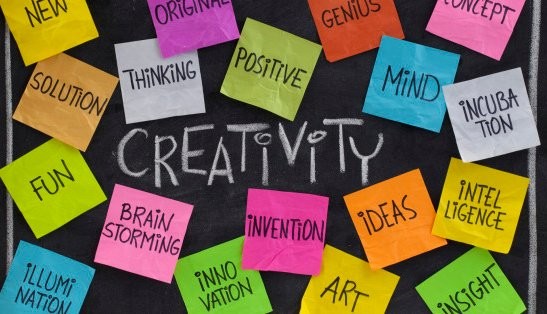
Design Thinking: 3 easy lessons from the book “Creative Confidence” to implement in your daily habits
You know the common picture, coming into an office and everyone sits behind the laptop or tablet. This is the usual way of working. However, if you don’t use a laptop but a piece of paper, pens and some post-its, you are recognized as a “design thinker”. Design thinking methods are the new trend for bringing corporate executives to the “zoo” of startups in a room full of toys and bright paper to become creative. Post-its decorate office walls of co-working spaces not just to bring color to the industry-look of lofts but also to structure thoughts in order to increase innovation. Besides workshops for corporates, David and Tom Kelley emphasize in their book “Creative Confidence” to implement design thinking in your daily habits in order to increase your flow of ideas and happiness.
Creativity. Creative people are those who sit in the classroom painting pictures or playing piano since they were 5 years old. There was a clear distinction between creative and analytical people already in our early ages. Creative people are good in languages, art and music. Analytic people are better in math and science. Hence, creative people study culture, languages or art and analytical people study economics, law or engineering. This underlines the feeling that you can decide for yourself very early if you are a creative person or not. Tom an David Kelley claim that everyone can be creative no matter what you studied, if you can draw, sing and dance or not. Creativity is like a muscle, which you can exercise.
Deviating the principle from above, I would describe myself as an analytical person. As many other economist, the most of us are taught to think solution-oriented. When there is a problem, find the right solution. We carry this way of thinking a long way with us and establish this way of working in our job. In situations in which we cannot find a clear solution, we start thinking outside the box and open our minds to see other aspects of the problem and also other possibilities for the solution. David Kelley states that this kind of thinking is the right one to start your creative muscle to work and to discover new ideas and innovations. If you want to increase your flow of ideas and innovations, activate your creative muscle. I would like to share the key insights I have gained from the book “Creative Confidence” with you. You can train your muscle with these three simple lessons, which you can easily implement in your daily routine.
Reframe every question
Every time we are confronted with a question, we want to solve it instantly by searching for the one and only solution. This is a simple reaction most of us have due to our routines we have learned. Imagine you have a challenge at work and you are collecting ideas to find the right solution. By reframing your questions, you easily open up your point of view and increase the quantity of ideas. For instance, “Imagine you have an invincibility coat that lets you overcome challenging processes or people. Where or when would you use this coat?”. First, it is important, not to focus on the quality of ideas because in the beginning, these kind of questions seem ridiculous. “If you want a good idea, start with a lot of ideas.” (Linus Pauling). Reframing questions will bring you in unknown situations that allow us to create a lot more ideas than before. Another simple example to start exercise reframing questions is for instance to not just ask a friend: “Why do you like this book?”. Instead, ask “Imagine you want to convince your friend of this book, what would you tell them?”. Bring your question to life by asking playful and creative questions. This already invites your partner to answer in the same way by thinking outside the box.
Rediscover familiar
You probably know this feeling when you drive to your job the same way as everyday and you park your car at the same parking lot as every day. You sit at your desk and you ask yourself “Did I lock my car?”. We all have situations in our daily life, which we do so routinely that we do not have to think about them anymore. We hardly recognize changes in these surroundings and are not open for new details anymore. Otherwise, when we travel we are so aware of all new details and get inspired by what we see. It is no secret that many ideas come from traveling. Even if we cannot travel the whole time, we still can train our creative muscle in our daily routine by simply rediscovering the familiar. Just change some parts of your daily habits for instance your way to work or the gym class you take. Rediscover your city and actively search for things you don’t know yet in your familiar surrounding. Instantly you will be more awake and open minded for new ideas. Keep your thinking fresh by reading articles from sources you are not used to.
Overcome knowing-doing gap
You probably know what is good for you and now you know some more. But the biggest problem we all face is the start of new habits. We are trapped in the knowing-doing gap, knowing all the things we should do and always saying – yeap, I start tomorrow or next week or even next month. However, bringing a new habit into your life, you can calculate 14 days. It takes approximately 14 days of daily routine to implement a new habit into our mind and body. So, you can implement creative thinking into you habits today to increase your flow of ideas for tomorrow!
Self Employed at Inspira Arquitectura Sostenible
7yI started reading a lot of science fiction 6 months ago and that has really broaden my thought process :)